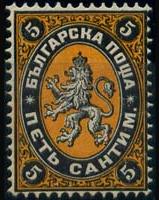 What Can Be Done: Bulgaria is an excellent country to collect. Until 1878 Bulgaria was part of the Ottoman (Turkish) Empire and used the stamps of Turkey. Specialists collect these stamps by identifying the Turkish stamps that were used in Bulgaria by the cancellations on the stamps. This is a thriving specialty. After independence Bulgaria issued its own stamps beginning in 1879. The early issues to 1900 are lovely examples of what nineteenth century stamp production represented to many smaller emerging nations – expressions of national sovereignty. The stamps are well designed, colorful and beautifully printed. Twentieth and twenty-first century Bulgarian philately divides into three broad categories. The first, going to WW II was from an independent Bulgaria. There are many lovely sets and, especially in the 1930s, many longer sports thematic sets that have become hard to find and expensive.
What Can Be Done: Bulgaria is an excellent country to collect. Until 1878 Bulgaria was part of the Ottoman (Turkish) Empire and used the stamps of Turkey. Specialists collect these stamps by identifying the Turkish stamps that were used in Bulgaria by the cancellations on the stamps. This is a thriving specialty. After independence Bulgaria issued its own stamps beginning in 1879. The early issues to 1900 are lovely examples of what nineteenth century stamp production represented to many smaller emerging nations – expressions of national sovereignty. The stamps are well designed, colorful and beautifully printed. Twentieth and twenty-first century Bulgarian philately divides into three broad categories. The first, going to WW II was from an independent Bulgaria. There are many lovely sets and, especially in the 1930s, many longer sports thematic sets that have become hard to find and expensive.
After WW II, Bulgaria was part of the Soviet bloc of countries. The Soviet issues for all of Eastern Europe and Russia have a similar quality. They issued far more issues than the postal necessity dictated. Philately was a government sponsored endeavor in the Soviet bloc. The stamps had a propagandistic quality with the stamps depicting a satisfied proletariat and happy workers, all during a time of a marked economic want in these countries. Further, philatelists bought their stamps form the government, so that by encouraging stamp collecting the Soviet bloc was selling their products to their citizens. Governments selling coins, currency and stamps to people that are not going to be redeemed is called seigniorage and is a form of taxation.
The post-independence era after 1991 is the third broad division of Bulgarian philately. Without government sponsored philatelic clubs, few of these issues were put away and many have proven to be scarce. The overall constraints on Bulgarian philately are two. First, the internal population of Bulgaria is small (only 7.5 million). The country is not wealthy and there are not many successful expatriates living in other countries who collect Bulgarian stamps. There are few philatelic areas that have wide appeal and rising prices without a strong internal market. And secondly, there are really too many issues-over 5000 as of 2015. When collectors look for a new specialty, the strike point seems to be about 2500 issues. That’s a manageable number that allows a collector to feel like he’s making progress fast enough to feel satisfied in his hobby. Most collectors never specifically formulate the “too many stamps” theorem for picking new countries to specialize in. But, it is noticeable that countries with fewer stamps, such as Denmark, gain far more new collectors than countries like Bulgaria.

Stamp Albums: Stick with the Scott Specialty series for Bulgaria. It’s a well designed and produced album in two or three volumes. The fancy Lighthouse and other European albums could set you back over a thousand dollars before you’ve collected even a single stamp. What many savvy collectors who are starting a new country do, is to look around in dealer listings for a nice Bulgaria collection in high quality, good condition albums. Such collections usually sell for only the value of the stamps and you get hundreds of dollars retail worth of albums for free.
Availability of Material: The availability of Bulgarian stamps breaks down along lines that are similar to how Bulgarian stamps are collected. Bulgarian usages on Turkish, Austrian and other country’s stamps are scarce and hard to find. Classic Bulgaria proper is easier to obtain but still a challenge. Soviet era material is readily available and the post 1991 period has many common stamps and many sets that are destined to be quite rare.
Expense: There are many difficulties and challenges in collecting Bulgaria. Cost is not one of them. Considering the rarity and beauty of Bulgaria nearly all of its stamps are modestly price.
Overall Grade: B+
